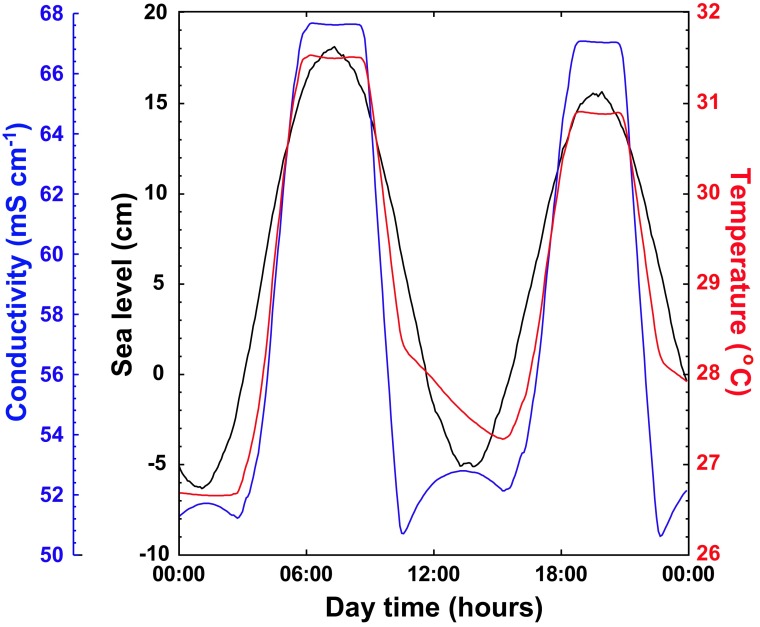The correct attribution of reductions in coral calcification rates to environmental parameters is key to predicting how coral reefs could respond under future climate change scenarios (1). Crook et al. (2) report a 35% reduction in the calcification rates of the coral Porites astreoides growing near submarine freshwater springs relative to specimens growing in the surrounding lagoon. Submarine springs in the area release intermittently ground water with low conductivity, low pH, low aragonite saturation (Ωarag), and for most of the year, low temperature (3, 4). Although Crook et al. (2) acknowledge the challenges of attributing to one single environmental variable the observed results when multiple parameters may covary, their main conclusion identifying low Ωarag as the sole driver for the observed reductions in coral calcification is misleading.
The flow of groundwater through the submarine springs is intermittent and ultimately controlled by sea level. During neap tides, submarine springs remain almost fully open, whereas during the spring tides, the springs close and open while tracking the semidiurnal tidal regime (Fig. 1). Once the sea level rises above a threshold and the spring closes, the center of the spring rapidly equilibrates with the bulk lagoon water as indicated by the rise in conductivity and temperature. In general, underwater springs remain open 75% of the time (4), although these periods can be significantly shorter depending on the prevailing oceanographic conditions. Crook et al. (2) assigned Ωarag values for each coral used in the study based on their location along gradients surveyed during three periods when the springs were active (3). As the intermittent nature of the groundwater sources was ignored, the hind-casted Ωarag experienced by coral colonies during their entire life was underestimated by at least 25%.
Fig. 1.
Typical diurnal sea level oscillations, conductivity, and temperature recoded at the center of the Pargos submarine spring. The data were collected every 15 min with a conductivity, temperature, and depth probe (Van Essen Instruments Mod. D1263) on August 7, 2010.
To overcome the challenges imposed by other environmental factors that covary with Ωarag, Crook et al. (2) compare their results with published laboratory studies in which the Ωarag was controlled by manipulating pCO2 while maintaining the other variables constant. Considering the agreement between the apparent sensitivity of the Yucatan corals with the results obtained from laboratory manipulations, Crook et al. (2) conclude that the observed reductions in P. asteroides calcification result exclusively from the Ωarag gradient, excluding any other factor. Unfortunately, using this comparative approximation while ignoring other well-known responses of coral calcification to covarying environmental parameters seriously compromises the conclusion.
Crook et al. (3) report a temperature difference between the springs and the lagoon of −4.45 °C (Fig. 1). These thermal anomalies would generate reductions in calcification of similar magnitude to those attributed to Ωarag (5). Furthermore, increased light scattering due to the mixture of waters with different densities result in increments, as high as 30%, in the vertical attenuation coefficient relative to the lagoon. These significant changes in the light environment and temperature, alone or in synergy, are enough to explain similar reductions in coral calcification than those reported by Crook et al. (2), therefore making their sole attribution of the results to low Ωarag uncertain.
Acknowledgments
We thank A. Valle-Livingston and I. Mariño-Tapia for fruitful discussions and for providing their unpublished data on flow dynamics of the submarine springs and E. Escalante-Mancera for data processing. The authors received funding from the European Union 7th Framework programme (P7/2007-2013) under Grant 244161 by the European Union under the Future of Reefs in a Changing Environment Project, Programa de Apoyos a Proyectos de Investigación e Innovación Tecnológica (IN206413), and Consejo Nacional de Ciencia y Tecnología (129880).
Footnotes
The authors declare no conflict of interest.
References
- 1.Hoegh-Guldberg O, et al. Coral reefs under rapid climate change and ocean acidification. Science. 2007;318(5857):1737–1742. doi: 10.1126/science.1152509. [DOI] [PubMed] [Google Scholar]
- 2.Crook ED, Cohen AL, Rebolledo-Vieyra M, Hernandez L, Paytan A. Reduced calcification and lack of acclimatization by coral colonies growing in areas of persistent natural acidification. Proc Natl Acad Sci USA. 2013;110(27):11044–11049. doi: 10.1073/pnas.1301589110. [DOI] [PMC free article] [PubMed] [Google Scholar]
- 3.Crook ED, Potts D, Rebolledo-Vieyra M, Hernández L, Paytan A. Calcifying coral abundance near low-pH springs: Implications for future ocean acidification. Coral Reefs. 2011;31(1):239–245. [Google Scholar]
- 4.Hofmann GE, et al. High-frequency dynamics of ocean pH: A multi-ecosystem comparison. PLoS ONE. 2011;6(12):e28983. doi: 10.1371/journal.pone.0028983. [DOI] [PMC free article] [PubMed] [Google Scholar]
- 5.De’ath G, Lough JM, Fabricius KE. Declining coral calcification on the Great Barrier Reef. Science. 2009;323(5910):116–119. doi: 10.1126/science.1165283. [DOI] [PubMed] [Google Scholar]



